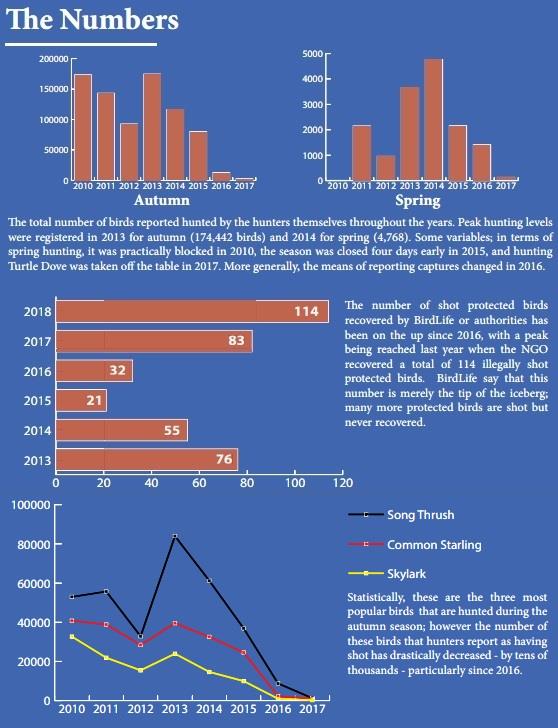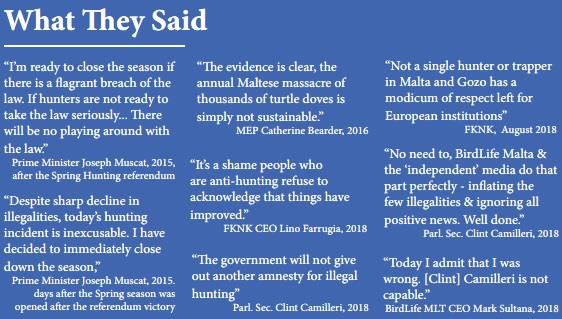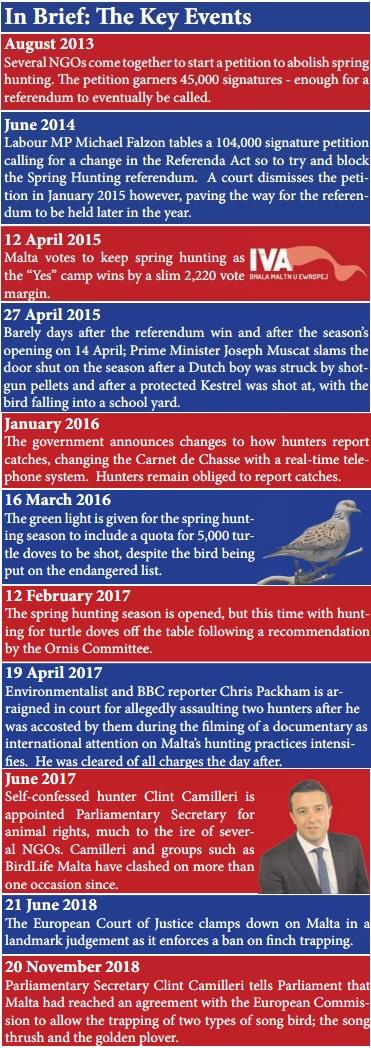An analysis of the number of birds that hunters report as catches compared with the number of illegally shot protected birds recovered by BirdLife Malta seem to point towards a trend wherein less birds are being reported as having been legally caught, and more illegally shot birds are being recovered by authorities NGOs such as BirdLife.
98.29% reduction in birds reported caught by hunters between 2013 and 2017
One of the most startling statistics that emerges from a simple year-by-year comparison of the birds that hunters report as having legally caught - something which they must do by law - shows that there has been a decrease of 98.29% in the amount of birds reported shot between 2013 and 2017.
2013 was, according to statistics issued by the government’s Wild Birds Regulation Unit (WBRU), the peak year for birds hunted legally, taking into account statistics between 2010 and 2017, with a total of 178,108 birds shot across both the autumn (174,442) and spring (3,666) seasons. Conversely, statistics issued by the same unit in 2017 show that during that year’s two hunting seasons, a total of just 3,054 birds were reported shot by hunters.
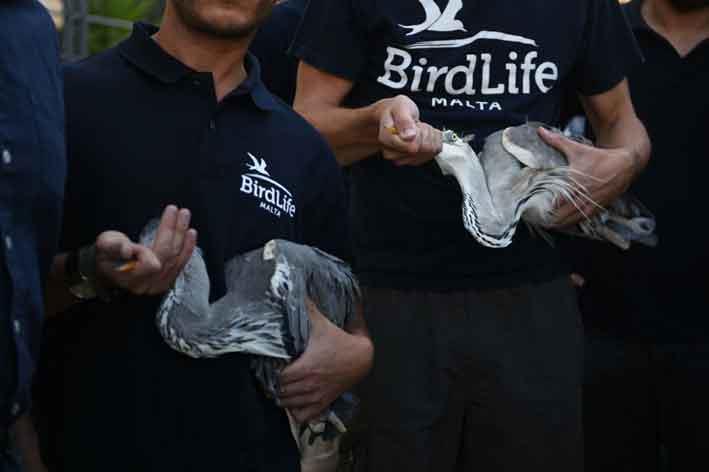
Before delving into the nitty gritty of these numbers, two differences between the two years should be noted. The first is that in 2017 the hunting of Turtle Dove was not permitted during the spring season; in 2013, 3,175 Turtle Doves were shot during the spring season. The second is that in 2016 a new method of reporting was introduced by the WBRU, replacing the old Carnet de Chasse with an immediate digital live reporting system. Furthermore, migratory fluctuations on a year-by-year basis are also not uncommon and are another variable to take into consideration.
Statistically speaking, the species of birds which find themselves in between hunter’s crosshairs most have always been the Song Thrush (Malvizz), Common Starling (Sturnell) and the Skylark (Alwetta). In fact, in 2013, hunters registered that they had shot 83,942 Song Thrushes, 39,529 Starlings and 23,920 Skylarks. In the case of the latter two, higher numbers of kills were registered in 2010, with 40,813 Starlings and 32,672 Skylarks shot in that year.
However, the data pertaining to these species in 2017 – which is the most recently available data for legal catches – paints a much more frugal picture; 1,228 Song Thrushes, 990 Common Starlings and 282 Skylarks were reported shot by hunters throughout the year, numbers which are comparatively miniscule.
The question therefore stands - why is there such a huge discrepancy between these numbers?
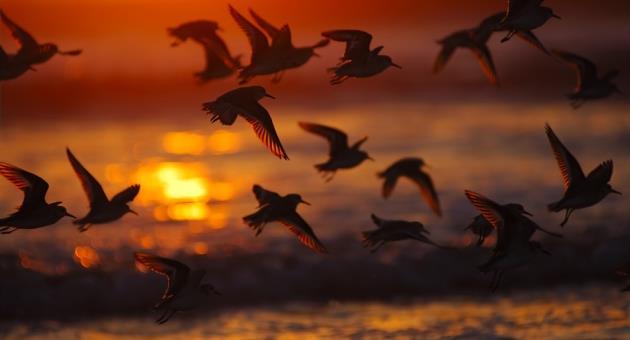
Over-inflation or under reporting?
The game reporting system used by hunters was changed in 2016 after amendments to the Conservation of Wild Birds law, meaning that an instant telephone system replaced the Carnet de Chasse, which was phased out earlier that same year. Hunters are, as specified by the WBRU itself, legally obliged to use the system to report any birds caught before leaving the hunting area.
However, the implementation of the new system coupled with the statistical reduction in registered catches has given rise to concerns that hunters are simply not reporting their kills. Speaking to Malta Today following the publication of the 2016 set of statistics – which were already a marked decrease from the previous year – BirdLife Malta’s conservation manager Nicholas Barbara had said that while migration fluctuations were normal, the across the board steep declines indicated that something was wrong. He said that the new system should have been introduced gradually, and wondered whether the WBRU was actually regulating the hunting season or trying to find “sorry excuses” to justify under-reporting.
The WBRU, however, stood by the system. In 2017, its head Sergei Golovkin insisted that the hunters’ figures were accurate and argued that the low percentage of hunters who declared a kill boiled down to a lack of interest, poor bird migration, and adverse weather conditions.
He cited poor migration patterns and bad weather as reasons for the reduction in the reporting of Turtle Dove and Quail catches, and claimed that hunters had actually over-reported catches of song thrush and starlings in the past. This was the case, he had said, because the Carnet de Chasse booklets were filled in by hunters at the end of the season “from memory”, and could have resulted in exaggerated reports across the board.
The hunting community meanwhile has also defended the new system. St. Hubert’s Hunters last year described the system as the most advanced in the EU and added that comparing figures from one season to another revealed a "lack of ornithological knowledge and an obvious devious purpose." They put 2017’s low figures down to a “dismal” migratory season and to a lot of licensed hunters choosing to stay at home for the duration of the season.
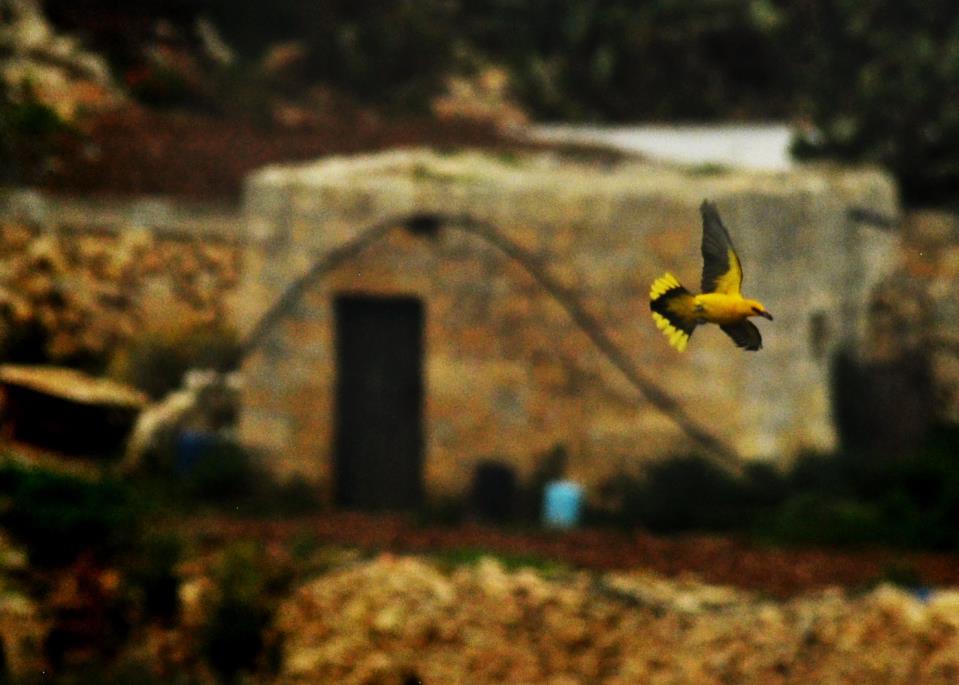
Rise in recovered illegally shot protected birds to a peak in 2018
Despite the substantial decrease in birds reported caught by hunters, the number of illegally shot protected birds recovered by authorities or civilians has jumped in the past years. The conclusion of the autumn season at the end of last January in fact brought the 2018 period to a close with 114 shot protected birds recovered.
The number is a six-year peak, and an increase on the 82 shot protected birds recovered in the 2017 period - which was in itself already a record for recent years.
These numbers are however just the tip of the iceberg, BirdLife Malta’s conservation manager Nicholas Barbara told The Malta Independent when the most recent autumn hunting season ended. Barbara explained that the figures are used to gain an indication of the level of illegal hunting being carried out. In fact, he said, they are only a small percentage of the birds which are killed, as most are picked up by hunters before passersby can come across them.
This all being said, animal rights parliamentary secretary Clint Camilleri - who's mere appointment to the post in 2017 caused ire for the simple reason that he is a hunter himself - said on the Malta Independent’s program Indepth last November that there has been good, sustainable progress with regards to illegal hunting, noting that in previous years there were reports of thousands of protected birds being shot over Malta and noted that there has been a “radical change” observed in the approach of hunters wherein this “trend has drastically decreased”.
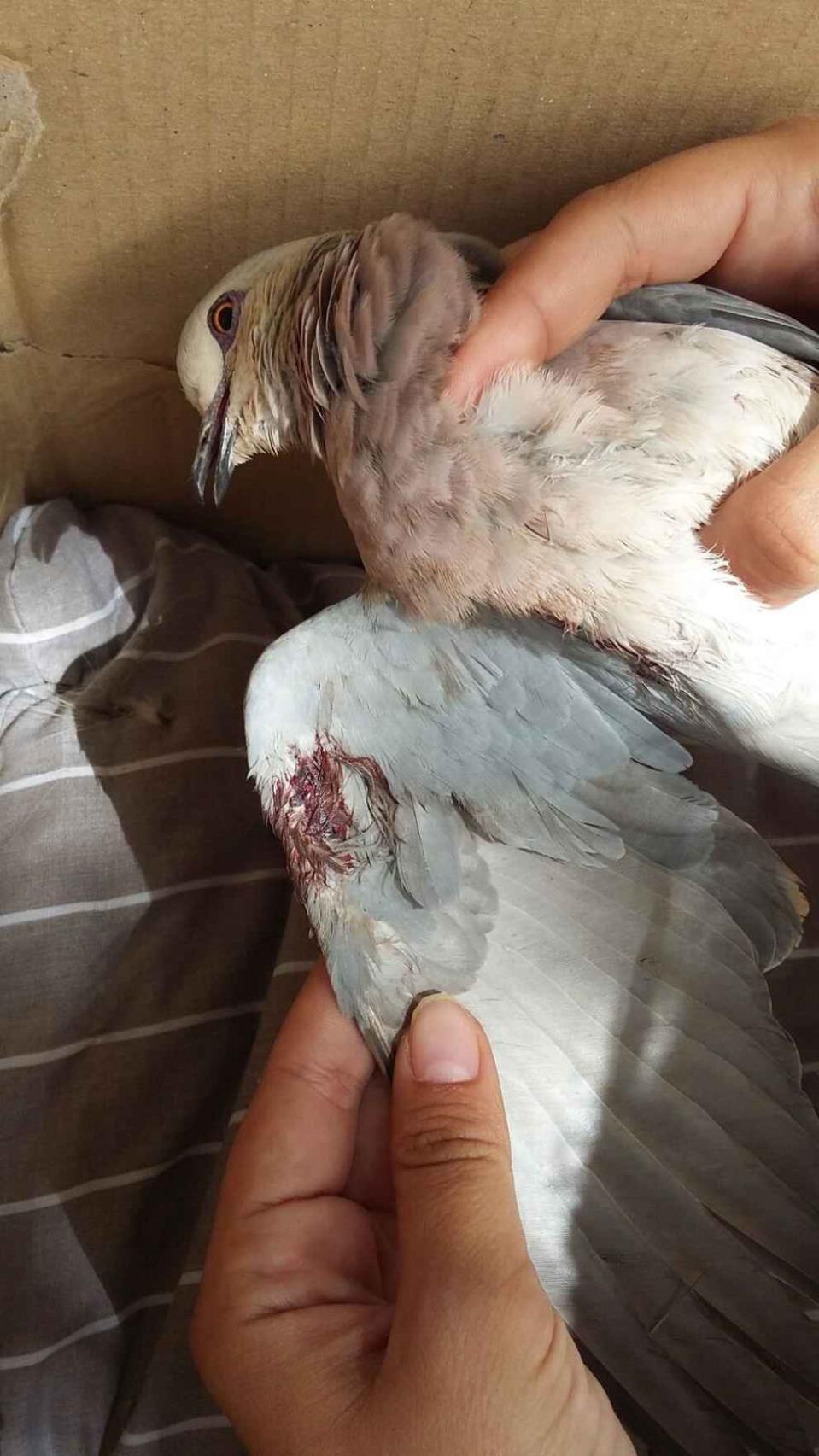
Asked about the amount of shot protected birds recovered in 2018, which when the program aired had already exceeded 100, Camilleri admitted that while it is true that there has been a “small spike” when compared with the previous couple of years, “one needs to understand that the majority of hunters are obeying the rules, but unfortunately there remain some hunters who are not obeying the rules and this is where enforcement plays a part and those who are caught are taken to court and slapped with substantial fines”.
Camilleri said that enforcement this year was also subject to a “radical change” in 2018 and that it had been much more rigid and strict than previous years noting that there were 40 policemen on the ground carrying out daily inspections in each hunting district as part of this enforcement work.
The parliamentary secretary said that the fact that the discussion on illegal hunting is now limited to a small number of shot protected birds, the shooting of which still remains unjustifiable, rather than the “thousands and millions” of birds which were reportedly shot annually by Maltese hunters showed that the situation was more “under control”.
Hunting is a long standing tradition in Malta, dating back centuries; however today it remains something of a polarising point, with hunters and environmentalists at loggerheads on more than the odd occasion here and there. Whilst the number of reported legal hunting catches in 2018 has yet to be shared by the WBRU, given the rise in the number of protected birds shot illegally it would be reasonable to conclude that this is a debate which will not be shelved anytime soon.
